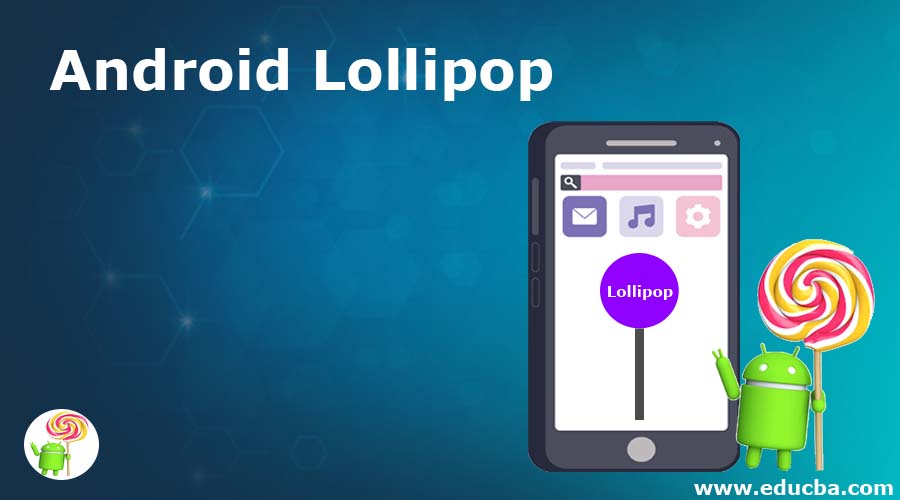Updated April 1, 2023
Introduction to Android Lollipop
The fifth-largest version of Google’s Android operating system was Version “LolliPop” (android 5). It’s Android’s 12th edition. The codename for development was Android L. The developer version of Android Lollipop appeared at the Google I/O conference on June 25, 2014. On 3 November 2014, it officially became public on the selected system that runs Android services distributions.
The redesigned user interface called Material Design is one of the key changes in the Lollipop release. Other improvements such as alerts that can be accessed and viewed from the lock screen. To boost application performance, Google is also changing its inner architecture by replacing the official Dalvik with Android Runtime.
Functions of Android Lollipop
Given below are the functions of android lollipop:
1. Notifications
The Android 5.0 updates are more visible, more available, and more configurable. If the user wishes, the lock screen can contain various notification information. None, any, or all notification information may be shown on a protected lock display by users. In the heads-up screen, a small floating window shows key screen notifications such as incoming calls that allow the user to respond or reject without leaving the current device.
You can now use new metadata to collect associated contacts (for ranking), the group, and priority notifications. A new media report template provides coherent media control for notifications with up to six action buttons, including custom controls like “thumbs up “— no more remote views are required.
2. High-performance Graphics
Khronos OpenGL ES 3.1 also offers 2D and 3D graphics capabilities on supported devices for games and other applications. OpenGL ES 3.1 introduces device shaders, stencil textures, visual effects, high-quality texture compression ETC2/EAC, state-of-the-art texture rendering, uniform size and render buffer formats, and more.
Android 5.0 is also presenting the Android Extension Pack (AEP), which offers you the ability to access such features as tessel shaders, geometry shaders, ASTC texture compression, interpolation and shading per sample, and other advanced rendering capabilities. AEP provides a wide variety of GPUs with high-performance graphics.
3. Enhanced Camera & Video
Android 5.0 includes all-new camera APIs for capturing raw formats like YUV and Bayer RAW and control parameters like exposure time, ISO sensitivity, and frame time per frame. The new completely synchronized camera pipeline helps you to capture YUV images with 30 FPS without compressing in full resolution on compatible computers.
The latest APIs would not only improve image capture power but also provide comprehensive information on camera capabilities and metadata detailing each frame’s capture environment. The H.265 High-Efficiency Video Coding (HEVC) apps for optimizing encoding and decoding video data now allow sending video streams over the Internet. Android 5.0 also provides multimedia tunnelling support for high definition (4 K) content and the ability to play compressed audio and video information together.
4. Battery Improvements
Google also launched the Volta project to improve battery life. The JobScedular API was announced by Project Volta that helps developers to optimize the app power usage. Finally, Google introduced Lollipop’s “Battery Saver” mode, which can be set up or automatically disabled manually if the battery is small.
5. Advanced Connectivity
In the Android 5.0 app, you will be able to search and advertise using new APIs that enable apps running simultaneous Bluetooth Low Energy operations. New multi-networking technologies allow devices to scan for accessible network functions, such as Wi-Fi, mobile, metered, or other network features.
The app will then request a connection and respond to a lack of connectivity or other network changes. Apps now allow NFC APIs to dynamically register an Assist. The card emulation service preferred by an active user is also set, and an NDEF record with UTF-8 text data is generated.
6. Lock Screen Enhancements
Android Lollipop provides ‘personal activation’ features, which allows the user to decide if the user is in the hand of the owner. It uses Bluetooth apps, which are available in the range, places, and even speech. For instance, the app may ask for a password when a Bluetooth watch is used, and it is deleted.
7. Material Design
Material Design allows developers to define the product elevation values within the application, providing shadow and perspective for the user automatically. Google also upgrades its popular Roboto typeface, enabling developers to use an optimized font on a variety of platforms.
Features of Android Lollipop
Given below are the features of android lollipop:
- Android lollipop supports the 64 bit CPU.
- Audio input and output via USB.
- Refreshed tray of notification and quick pull-down configuration.
- More apps are available for guest logins and multiple user accounts.
- For security purposes, WebViews automatically gets updates from Google Play.
- This shall be disabled until the user logs in to their Google Account when the Device is stolen or lost.
Recommended Articles
This is a guide to Android Lollipop. Here we discuss the introduction to Android Lollipop and its functions along with features. You can also go through our other suggested articles to learn more –


